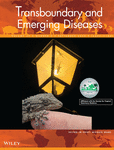Transboundary and emerging diseases and globalization. Have we scored an own goal?
Globalization has been described as the process of interaction and integration among people, companies, and governments worldwide. It is a term used to describe the increasing connectedness and interdependence of world cultures and economies. The term “web of globalization” has been coined to graphically illustrate the connections formed over millennia: like the threads of an immense spider web, the number and reach of these connections invariably increase over time (https://education.nationalgeographic.org/resource/globalization, accessed 22 July 2022).
Globalization as a concept is highly contested, and the term itself has been misused and overused (Lee, 2004). It has been explained as a construct of spatial, temporal, and cognitive changes. Spatial changes include the increase in the movement of people, animals, and goods across borders, and the re-definition of what is a local area or region. The extent of these changes can even make national borders irrelevant. Temporal changes are apparent in the speed with which connections are made, and the rate at which movements occur, and cognitive changes describe how we perceive ourselves as part of a connected world, the concept of a “global village”.
The potential effect of globalization on the spread of infectious disease has been well recognized. When the journal Emerging Infectious Diseases was launched in 1995, the historical context of disease spread via translocation events—war, travel, and trade—was reviewed (Morse, 1995). And it was noted that in recent years, the opportunities for disease spread have become “far richer and more numerous, reflecting the increasing volume, scope, and speed of traffic in an increasingly mobile world.” At the launch of Transboundary and Emerging Diseases in 2008, the editors identified the rapid growth in international transport of both humans and animals as the key driver of health threats on a scale never encountered previously (Kitching et al., 2008). Proposed drivers of emergence and resurgence of infectious disease have been cited for some time now; besides increasing long-distance mobility and trade, there is urbanization, the social disruption of war and conflict, changes in behaviour and human-induced global changes including widespread forest clearance and climate change (Weiss & McMichael, 2004). Thus, we can consider emerging diseases and pandemics in the age of the Anthropocene (David et al., 2021). But is globalization, however we wish to define it, part of the mix?
Particularly in the case of animal and zoonotic diseases, network analysis has been used to understand the connections that underlie disease spread pathways. For example, Buttner et al. (2015) analyzed animal movements within the pork supply chain of a producer group in Northern Germany, showing how networks change over time with potential to affect disease spread. Network analysis has been used to inform disease control and surveillance (Brookes et al., 2019), and known network vulnerability to disruption can be taken advantage of within strategies to control disease spread (Rautureau et al., 2011). In addition, these methods have been used to explore policy networks and decision-making during disease outbreaks (Schemann et al., 2014), and human network behaviour in terms of its potential association with animal diseases (Gabriel-Rivet et al., 2019). Recently, the value of network analysis has been recognized when applied to the COVID-19 pandemic (Pinheiro et al., 2021). And “contact-tracing” has become part of our common language in the era of COVID-19. However, most studies using network analysis methods are small in scale, limited by the detailed data needed to undertake analyses. While such studies address the issue of connectivity and disease spread, these do not generate strong evidence regarding the emergence and resurgence of infectious diseases and globalization.
So the question remains, is globalization a driver of the emergence and resurgence of infectious diseases of humans and animals? During the past few years, three major transboundary diseases have spread within Southeast Asia: African Swine Fever (ASF; Mighell & Ward, 2022), Lumpy Skin Disease (Arjkumpa et al., 2021; Tran et al., 2021), and Foot and Mouth Disease (https://www.agriculture.gov.au/about/news/media-releases/media-statement-foot-and-mouth-disease-detected-indonesia, accessed 17 July 2022). In the case of ASF, disease has spread as far as Indonesia, Timor Leste, and Papua New Guinea. It is tempting to speculate that the spread of these three infectious diseases is not simply coincidence, but that increasing connectivity in this region—as exemplified by the trade in livestock and livestock products—and the process of globalization lies behind these events. The movement of live pigs, vehicles, and personnel are key factors in the spread of ASF virus in China (Cheng & Ward, 2022; Gao et al., 2021), and preliminary data analysis suggests that global connectivity increases the risk of its transboundary spread (Ito et al., 2022). However, in most cases defining the sources and mechanisms of transboundary spread remains elusive (Indi Dharmayanti et al., 2021). Although risk assessments can be undertaken to estimate the risk of spread of diseases such as ASF associated with globalization (Beltran-Alcrudo et al., 2019), by their nature risk assessments do not generate evidence of causation. Measures of globalization exist, incorporating economic, social and political indicators. Detailed analysis of the association between disease spread events and these measures could generate evidence to support the role of globalization. Such rigorous testing of this hypothesis is needed, so that strategies to address the potential negative impacts of globalization can be developed. Rather than remaining as an abstract concept, it is important to define and quantify the relationship between globalization and disease emergence. The current trend of increasing globalization is unlikely to change in the medium to long term, so its effects need to be understood within the context of the emergence and resurgence of infectious diseases. If indeed globalization is an important driver of disease emergence and resurgence, we have created the conditions for increasing disease risks. So yes, we have therefore scored an own goal. How to live with globalization and minimize disease risk then becomes a major challenge in the age of the Anthropocene. For this, we look towards appropriate, well-designed and conducted research to show us the way.




